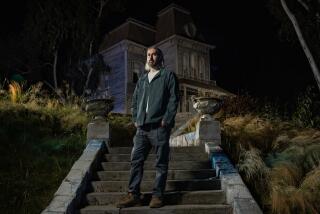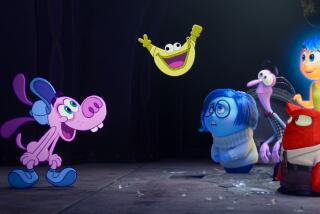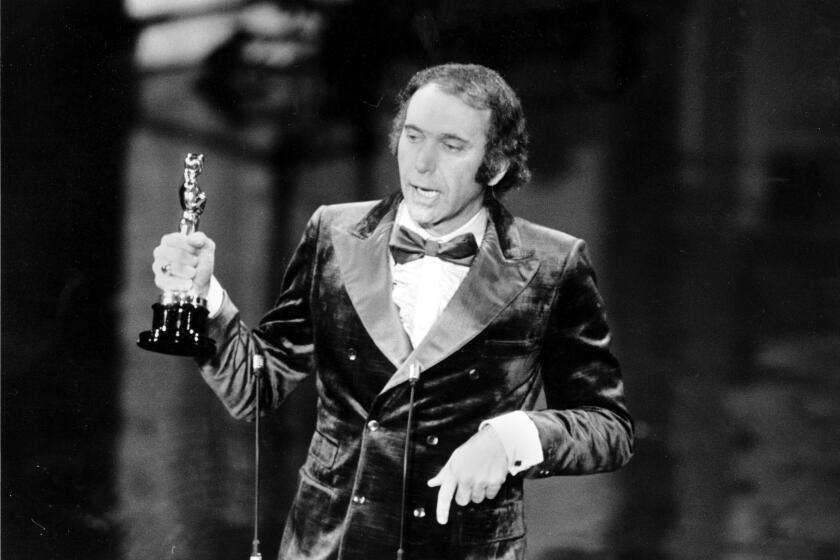Yasujiro Ozu excelled in his quiet moments
Legendary director Yasujiro Ozu’s rigorously spare style was often marked by long, slow takes -- the camera set at the eye level of a person sitting on the tatami matting that cover the floors of a traditional Japanese home. With so little camera movement, the rare pan shot became a uniquely expressive event.
His films remain tremendously evocative, with a flourish of superbly composed images introducing key scenes. Shots of people entering and exiting a room -- Ozu loved to shoot down corridors -- become expressive not only of everyday life being lived but beyond that, of the transitory quality of life itself. (It’s not coincidental that his post-World War II films frequently had one of the four seasons in their titles.)
It wasn’t until years after his death in 1963 on his 60th birthday, however, that Ozu came to be regarded by filmmakers, historians and critics as an all-time-great filmmaker. Among Ozu’s admirers are such internationally renowned auteurs as Jim Jarmusch, Stanley Kwan, Aki Kaurismaki, Claire Denis, Hou Hsiao-Hsien and Wim Wenders.
Ozu, who never married and lived with his mother until his death, was also a master delineator of family life and relations between adults and their children. His films, which will be featured this week by the UCLA Film Archive and LACMA, are suffused with warmth, compassion and humor and are remarkable for the power of their understatement.
“Any filmmaker who really loves movies and is interested in what they can do gets to Ozu, who becomes lovely, sacred soil to them, a very special achievement,” said another admirer, filmmaker Paul Schrader. “Really, all you can do is stand back and look at his movies and be baffled by how they’re done.”
Schrader became intoxicated with Ozu’s style when he was a film student at UCLA and later published “Transcendental Style in Film,” a 1972 exploration of spirituality in film, which focused on Ozu as well as Danish filmmaker Carl Theodor Dreyer and French director Robert Bresson.
Currently preparing the release of an “Exorcist” prequel, Schrader took time out to discuss Ozu by phone from his Manhattan office. The filmmaker said his own work -- including “American Gigolo,” “Taxi Driver” and “Raging Bull” -- was influenced by Ozu.
Schrader said that tracing Ozu’s influence on other directors is “a hard angle to take -- first, because Ozu is unique to the Japanese cinema, and second, the Japanese culture he reflected in his films is long gone. But Ozu shows us what movies can do when they go quiet.
“To watch an Ozu film makes you think about not moving the camera so much, to slow down on the editing and the performances, letting the performances unfold,” Schrader said. “When you start to do this you start getting things you don’t expect from movies. This lets the audience know you’re playing for big stakes. Making a movie is like playing poker: if you’re just going to have a good time you play for low stakes. But if you play slower you let the viewer know that there’s a lot of money in the pot at the end of the game, and that somebody is going to get rich.
“But how do you do that? Ford could stop a movie and go with lyrical passages, but nobody can do it like he could.”
Slowing the pace
Even so, Schrader has discovered that it’s worth trying to go slower than action-oriented American audiences expect. “Ozu shows us that movies can work in a different way from what Americans have assumed. That ... seeps into your consciousness as a filmmaker.”
Schrader, who grew up in Michigan, said he lived a sheltered childhood and saw his first movie at 17. When he discovered Ozu after arriving at UCLA as a young man, the filmmaker’s work struck a chord within him.
Schrader, now 58, was a film student at the university in the 1960s when the major Japanese studios still had their own theaters in Los Angeles and catered to the city’s large Japanese American community. Schrader recalls watching Ozu’s final film, the 1962 “An Autumn Afternoon,” during a revival there. When Schrader became a fellow at the American Film Institute, he persuaded Shochiku, Ozu’s longtime studio, to screen Ozu’s postwar films for him.
“I came to UCLA fresh from theological school -- Calvin College, a Dutch Calvinist college in Grand Rapids,” Schrader said. “All this theology fell in line with my interest in films in relation to their spirituality.”
From fall 1968 through 1969, Schrader was film critic for the pioneering alternative weekly the Los Angeles Free Press and made a name for himself with provocative reviews that echoed the concerns of the movies and screenplays of his own films, “The Yakuza,” “Mishima” and “American Gigolo.” Schrader also wrote “Taxi Driver” for Martin Scorsese and co-wrote Scorsese’s “Raging Bull.”
In Ozu, Schrader discovered an Asian counterpart to the revered and better-known Dreyer and Bresson. He was moved to spend a year and half writing his book, linking Ozu, Dreyer and Bresson. He says in retrospect he was really too young to write the book but knew that only at that age would he devote such a period of time to such a project. Looking back, he says, “It’s a very cautious book, very elitist, with lots of footnotes.”
‘You can’t top him’
Schrader said that although Ozu is without parallel -- “You can’t make an Ozu film any more than you can make a Sturges comedy or a Ford western. You can’t top him” -- his distinctive styles have been reflected in a number of films.
He cites Korean filmmaker Kim Ki-Duk’s “Spring, Summer, Fall, Winter ... and Spring” as a recent example, and Hirokazu Koreeda’s 1995 “Maborosi,” which means “illusion” or “mirage,” has the feel of an Ozu classic, sharing an understanding of the power of precisely composed images coupled with an innate understanding of how long to hold a shot until it’s suffused with meaning and emotion.
Two films recently screened at the Toronto festival were homages to Ozu: Abbas Kiarostami’s “Five” and Hou’s “Cafe Lumiere.”
Schrader ranks his favorite Ozu films starting with “Tokyo Story” (1953), widely regarded as Ozu’s masterwork; “Late Spring” (1949) and “An Autumn Afternoon.” Schrader is quick to add that some of Ozu’s many films didn’t always work but were peerless when they did.
“Tokyo Story” is replete with deceptive simplicity: an elderly couple (Chishu Ryu, Ozu’s reflective alter ego virtually throughout the director’s career, and Chieko Higashiyama) visit their adult children in Tokyo, only to find that they are not as successful as they had assumed, and have little time for their elders. The couple returns home and the wife dies soon after. So detached, yet so committed is Ozu’s approach that “Tokyo Story” reverberates with the brevity and preciousness of life.
“Late Spring” contains one of the defining moments of all Ozu films and is played by the actors Schrader believes Ozu revered most: Ryu and Setsuko Hara. A widower, Ryu, listens as his adult daughter, Hara, says that she would rather stay with him than marry. But the father, whose devotion to his daughter is palpable, tells her with the utmost reticence, and yet with kindness, that she must leave him and make her own life. “That’s the cycle that is the history of human life,” the father says.
.Schrader mused for a moment about Ozu, an intensely private man and the solitary life he lived. It may be that Ozu simply poured all of himself into his work, he said, adding that the love Ozu expressed onscreen through Hara surpasses what most people are capable of expressing for their own mates.
All anyone can do in regard to Ozu, Schrader said, is view his towering achievements with “reverence and bafflement.”
*
Yasujiro Ozu
Where: James Bridges Theater, 1409 Melnitz Hall UCLA Campus, Westwood
When: Nov. 5 to 27
Contact: (310) 206-8013 or www.cinema.ucla.edu
Also
Where: Bing Theater at LACMA, 5905 Wilshire Blvd., L.A.
When: Nov. 4 to Dec. 11
Contact: (323) 857-6010 or www.lacma.org
More to Read
Only good movies
Get the Indie Focus newsletter, Mark Olsen's weekly guide to the world of cinema.
You may occasionally receive promotional content from the Los Angeles Times.






